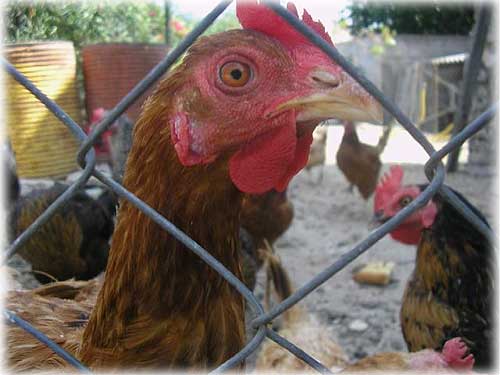 by Preston MacDougall January 17, 2006
It could, in fact, be overheard during a tit for tat round of You Sunk My Battleship! But the deadly significance of this alphanumeric string is not imaginary - it is a real concern. H5N1 is the name that scientists have given to the virus that is responsible for the current outbreaks of so-called "bird flu" in Asia. The last figure that I saw put the human death toll, from confirmed cases of avian influenza, at 81. If you count our feathered friends, the total death toll is already over 150 million poultry that have either died as a result of being infected by the virus, or were destroyed to control its spread.  Photo Credit: www.morguefile.com
A worrisome fact is that not all birds that carry the H5N1 virus get sick. Ducks in particular are known to be potential carriers, and they can have far-reaching migrations. Birds spread the virus among themselves through their saliva and excrement. Presumably this is also how people and cats have been infected. Another worrisome fact is that, like all forms of life, H5N1 can undergo mutation. It is only one of many strains of avian flu virus. Others go by similar names such as H5N7 and H9N2. Without going into too much chemical detail, which quickly gets beyond my expertise, these viruses and their mutant cousins are named according to subtypes of molecules that protrude from the external surface of the virus. These protruding molecules are signals to our immune system, and the response determines how sick we might get if infected. Two such molecules are hemagglutinin and neuraminidase, and this is the origin of the H and the N in the virus names, respectively. The former is a glycoprotein - which means that it is a large molecule constructed from amino acids and sugars - while the latter is a protein made entirely of amino acids. They each come in a variety of slightly differing molecular structures, resulting from the aforementioned mutations. H5 with N1 is the deadly combination that is currently wreaking havoc in the bird world. Enzymes are protein molecules that catalyze chemical reactions in living organisms (although they can also be studied in test-tubes). These reactions can involve making and/or breaking chemical bonds. Neuraminidase is a cleaving enzyme. It breaks the chemical bonds that tether the virus to the cell in which it was produced. Although one virus can only infect a single cell, that cell can then produce many copies of the virus. Neuraminidase is thus crucial to the spread the disease. It will also be key to containment of the disease, because that is how the drug Tamiflu works - it inhibits the chemical activity of the neuraminidase molecules on the virus. Tamiflu was designed for the human influenza A virus, not for the deadly H5N1 virus spreading among birds. But the chemical similarities of the various neuraminidase subtypes mean that it should be an effective treatment for people who get "bird flu". The production of this chemical compound, which was co-developed by Roche Pharmaceutical in New Jersey, and Gilead Sciences in California, is currently being escalated in anticipation of possibly surging demand. Fortunately, the H5N1 virus does not seem to be able to spread from human to human - nor from cat to cat - and this has prevented the multiple epidemics from becoming one giant pandemic. It is noteworthy that pathologists from the U.S. Department of Defense reported evidence (based on analyses of the genomes of numerous viruses) that the 1918 "Spanish" influenza pandemic - which was transmissible and killed an estimated 50 million people - was derived from an avian strain (Taubenberger et al., Nature, October 6, 2005). This is a rapidly evolving public health issue, and the more that individuals know about it, the better off we all will be if bad turns to worse. The World Health Organization has an excellent website, in multiple languages, that is updated every day. You can get there by going to www.who.org. My paternal grandfather had an endless supply of jokes. Lots of them started off the same, but the ending would change over time. He would fiddle with them, and then test them out on me. It seemed as though he was equally pleased if they elicited a chuckle or a groan. I can't remember a single ending to the ones that began "If chickens had lips", but thank goodness they don't.
Publish A Letter on SitNews Read Letters/Opinions Submit A Letter to the Editor
|